Matador Network's Blog, page 928
February 4, 2020
Best natural mud baths to try

From flothetta to snake massages, there are many wellness rituals that different cultures believe to be vital for good health. One common treatment ingredient that shows up throughout history and around the world is mud. Ancient Greeks believed that mud could heal ulcers and migraines. In Bulgarian culture, mud is also said to have anti-inflammatory and detoxifying properties. Whether these claims are to be fully believed or not, one thing is undeniable — soaking in a mud bath can be an incredibly relaxing, and oftentimes joy-inducing, experience. Here are nine mud baths to try around the world.
1. Hell’s Gate — New Zealand

Photo: Joe Benning/Shutterstock
Also known as “the center of Earth,” Hell’s Gate is one of New Zealand’s most historic spots, fabled for the healing properties of its mud. According to the Māori who have ritualized the practice for over 800 years, the thermal mud and sulfur-rich mineral water revitalize the whole body. At Hell’s Gate, travelers can choose their own experience, such as having a private mud bath or going for a semi-private sulfur spa. A “Tikitere Experience” includes a walk through the geothermal reserve where land coral, active mud volcanoes, and geysers can be found, followed by a sulfur soak.
2. El Totumo — Colombia

Photo: max blain/Shutterstock
Colombia’s El Totumo volcano offers a messy, fully immersive mud bath experience. As legend has it, a local priest “tamed” this volcano hundreds of years ago, and turned it from a deadly force of nature into a revitalizing spa. Descending down a steep ladder into the mud, visitors will soon realize the intimacy of the experience given the modest size of the pool. Nobody comes out of El Totumo clean — wellness-enthusiasts will be fully covered in mud, head to toe. There is a place to wash up after the experience, where the local women hand out towels and help remove the mud from bathers’ hair.
3. Boryeong Mud Festival — Boryeong, South Korea

Photo: yochika photographer/Shutterstock
When it comes to skincare, no one gets more creative than South Korea. Believed to soften skin and give it that coveted glisten, mud has been properly celebrated here for centuries. Every July, there is even a festival dedicated to the stuff. Boryeong Mud Festival takes the love for mud to a whole new level, celebrating it with face painting, mudslides, mud pools, bouncy castles, and events which travelers can (and should) attend fully covered in mud.
4. Lake Techirghiol — Romania
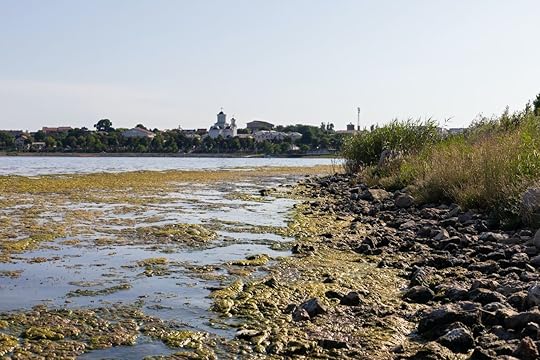
Photo: Ocskay Mark/Shutterstock
Romanian legend has it that an old man got stuck in the mud while crossing Lake Techirghiol and to his surprise, upon getting out, he realized that his eyes were cured and he could see like a young man again. Since then, locals have frequented the lake hoping to feel rejuvenated. A popular summer vacation spot, Lake Techirghiol makes for a great day trip for those who want to see if the legend is true and experience Romania’s vibrant and affordable Black Sea coast.
5. Milky Way Lagoon — Palau

Photo: howamo/Shutterstock
Palau is an island full of surprises and its Milky Way Lagoon is not what one might expect a mud bath to look like. Turquoise blue water covers a smooth clay bottom tucked into a secluded area of the island that can only be reached by boat. Here, travelers will find the type of clay that has gained a great level of popularity in the beauty and wellness world for its said properties of rejuvenating skin and making it appear younger.
6. Lake Atanasovsko — Burgas, Bulgaria

Photo: Pencho Tihov/Shutterstock
Bulgarians believe in the healing power of mud baths as a way to cure rheumatism, with more than 5,000 locals visiting Lake Atanasovsko during a three-day wellness weekend in August. Located just under two miles out of Burgas, locals and travelers can hike to the lake as a part of their wellness routine.
7. Miravalles Volcano — Costa Rica

Photo: Eugenie Robitaille/Shutterstock
Costa Rica’s pura vida lifestyle translates into the reverence of wellness as a part of local culture and values. Located in the Guanacaste Province just 30 miles out of Liberia, Miravalles Volcano is a hotspot for mud baths and soaks. Locals and travelers come here to experience the healthy properties of the mud’s minerals. Make a day out of it by going for a hike and visiting the area’s Yoko Termales hot springs.
8. Lake Köyceğiz — Dalyan, Turkey

Photo: Oleg Golovnev/Shutterstock
Turkish culture highly values mud baths as a way to remove eczema and heal arthritis. The mud in Lake Köyceğiz has a very high density and salt content, making bodies float right up — providing an added relaxation benefit. The bottom of the lake is covered in stones that prevent slipping, so there is no need for special shoes.
9. Askja Volcano — Iceland
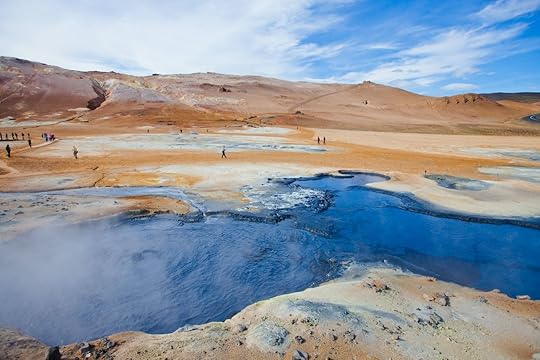
Photo: Tsuguliev/Shutterstock
Located in a remote part of Iceland, Askja is a much more low-key spot than the famous Blue Lagoon when health and wellness are the priority. Hike 30 minutes up to the crater of Víti Volcano to enjoy a full-on mud soak. Many prefer Askja for its turquoise water that makes for the perfect background panorama to accompany the bath. 

More like this: The most luxurious spa treatments to treat yourself to around the world
The post 9 famous natural mud baths around the world to sink into appeared first on Matador Network.

South Carolina farm pig cuddlers

If you can’t help but ooh and aah at the sight of twisty tails, hooves, and round, pink bodies, there’s a job waiting for you in South Carolina. The Cotton Branch Farm in Leesville is looking for piggy cuddlers to help socialize 100 rescue pigs, so they can eventually find a permanent home. The group of 100 pigs are part of a larger group of 550 that were rescued from Kentucky.
The job notice, posted on Facebook, calls for pig enthusiasts to “come help socialize our adoptable residents so they can move into our adoption program with ease! Belly scratches, cookies, sitting with, and even just talking to our pig friends can get them ready for their new home.”
Being a piggy cuddler isn’t too demanding a job. Josh Carpenter-Costner, Cotton Sanctuary’s executive director, said that if cuddlers “spend an hour at a time with them three times a week, within a month they’re generally ready to be adopted.”
So don’t quit your day job, but if you’re a pig lover, then there definitely could be some cuddling in your future. 

More like this: From playing with Chernobyl dogs to cuddling with cows, these are the coolest new animal experiences on Airbnb
The post A farm is looking for ‘piggy cuddlers’ to help socialize its rescue pigs appeared first on Matador Network.

Volunteers save pets in Wuhan

In the middle of the coronavirus outbreak, a key demographic is being neglected — pets. In Wuhan, the center of the virus outbreak, travel bans and quarantines have trapped many pet owners away from home, meaning their animals are being left to fend for themselves. An estimated 50,000 pets had been left at home around the time of the lockdown which coincided with the Lunar New Year, so local volunteers are stepping up to make sure those pets are safe.
Lao Mao — a pseudonym meaning “Old Cat” — is one of the volunteers spearheading the mission to feed pets left alone during the isolation. “The volunteers on our team, me included, have saved more than 1,000 pets since January 25th,” he told Reuters. “My phone never stops ringing these days. I barely sleep […] My conservative estimate is that around 5,000 are still trapped, and they may die of starvation in the coming days.”
Unsubstantiated rumors claiming that animals may be contributing to the virus’ spread, have led to a number of abandoned pets, and the threat of extermination of dogs wandering the streets.
Lao Mao and his team can’t save every single pet in China, but they’re doing their best to visit as many homes as they can, entering by whatever means necessary — with the knowledge and approval of owners, of course — and making sure pets get the food, water, and care they need. 

More like this: Racist panic over coronavirus will not help the people of China
The post Volunteers are breaking into homes in Wuhan to rescue abandoned pets appeared first on Matador Network.

February 3, 2020
Park City, Utah, best things to do

There’s nothing worse than being on a ski vacation and having absolutely no interest in skiing. Ok, maybe not nothing worse, especially if you enjoy spending entire days inside a snowy condo with a good book. But should you want to get outside and explore, sometimes it seems ski towns really don’t offer much outside of eating, drinking, and… skiing.
This is not the case, however, in Park City, Utah. The home of the famous Sundance Film Festival is also home to some fascinating history, unique dining experiences, craft distilleries, and live music. It might just be the best place to go on a ski vacation and never see the slopes. Though the powder in Utah is among the best in the world, sometimes you might not feel like shredding it. Here’s the best stuff to do in Park City in winter that won’t involve wearing snow pants.
Stroll through the historic Main Street.

Photo: Park City Chamber/Bureau
Long before it was a worldwide ski destination, Park City was a gritty little mining town deep in the Wasatch Mountains. Unlike many ski towns, which were effectively built for the sport, Park City has a history dating back over 150 years. And you’ll find over 400 historically protected buildings in the city, each with a novel story to tell.
The best way to appreciate it is by taking a stroll from the bottom to the top of Main Street. Here you’ll find colorfully painted buildings that once housed saloons, brothels, and trading posts. Today they’re filled with upscale boutiques and gourmet ice cream shops, as well as chic restaurants and a brewery taproom. Feel free to roam on your own, but if you want some direction, the Park City Museum offers walking tours as well.
To maintain its historical integrity, Park City has a highly strict policy of allowing no chain stores in its downtown. Which means the boutiques, restaurants, bars, and outfitters you’ll find there are exclusive to Park City. The exception to this rule are outdoor equipment and apparel stores — think Patagonia or Athleta — that must operate as flagship stores, selling items that can only be found in Park City. So if you were planning on picking up a souvenir $60 Park City workout shirt on your trip, you won’t have to look far.
Be a kid again in a massive indoor recreation center.

Photo: Woodward Park City/Facebook
About 10 minutes from downtown you’ll find a massive complex of black warehouses set against a series of soft slopes, where screaming families in tubes race down the mountain. It’s Woodward Park City, a 60-acre adventure complex, where in addition to tubing it offers an indoor skate park, parkour courses, gymnastics facilities with spring floors, and a massive trampoline center. There’s even a digital media school where you can play with GoPros and drones to learn the tricks of capturing adventure sports.
You don’t need to be a kid to use anything at Woodward, though the crowd definitely skews young. That said, it’s an excellent way to spend a family day off the slopes, and if you go during summer you can also explore the mountain biking trails and BMX courses.
Sample craft spirits and beers.
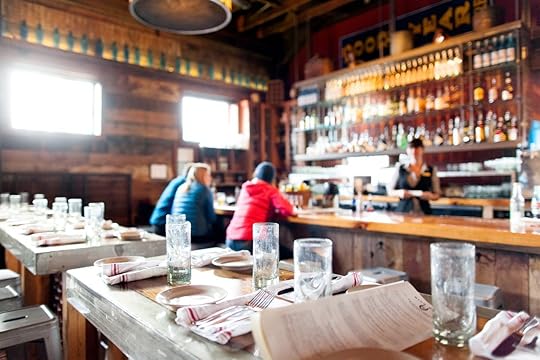
Photo: Park City Chamber/Bureau
Alcohol laws in Utah aren’t quite as archaic as they were even a couple of years ago, and in downtown Park City, you’ll find two particularly cool places to drink. The first is the High West Saloon on Park Avenue near Main Street. It’s an outpost for the distillery of the same name, set inside a turn-of-the-century horse livery that was later a garage and a car dealership. The old wood sign for the National Garage still stands out front, and you can enjoy craft cocktails and a full menu under pitched ceilings that have stood for over a century. Venture out of town about 15 minutes to Wanship and you can visit the actual distillery, take a tour, and enjoy lunch at Yuta at the Lodge at Blue Sky next door.

Photo: Wasatch Brewery/Facebook
You can also find a couple of solid craft breweries in and around Park City. The Wasatch Brewery has a massive taproom and restaurant, which is as much a place for family meals as it is a place to knock back a pint of Polygamist Porter. But it also offers a rotating selection of stuff you can only get there, so maybe try branching out. About 15 minutes north of town, Salt Lake City’s Red Rock Brewing has a taproom near Kimball Junction that also offers a full bar and wine selections.
Also worth visiting on Main Street is the , a narrow drinking den with animal heads on the wall and buffalo burgers on the menu. The Alamo-shaped brick building dates back to 1901 and was a mercantile and phone company before it opened as No Name in 1999. It’s the odd Main Street spot where you’ll find locals bellied up to the bar talking to tourists from all over the world, a laid-back oasis in the middle of upscale downtown. Just be prepared during high season, as you’ll likely have to stand up or wait for a table.
Learn about the city’s Wild West past.

Photo: Park City Museum/Facebook
Park City is the most historic ski town in America, and you’d be remiss to leave here without understanding its role in the Wild West. The Park City Museum tells the story beautifully; here, you can jump in an old stagecoach and learn about how early settlers arrived. Or step inside a re-created 19th-century mine and understand exactly how brutal that work really was.
You can also get into the old “skier subway” — old mining cars used to take skiers to the top of the mountain before the advent of ski lifts.
But hands-down the coolest thing in the museum are the old Utah Territorial Jail Cells. These were effectively holding cells under City Hall that held some of the most notorious criminals in state history. It’s a haunting look at criminal justice 150 years ago and a fascinating look into Utah’s crime-filled past.
Après ski!

Photo: Park City Chamber/Bureau
Probably the best thing about après skis is that you don’t have to do any actual skiing to enjoy one. And Park City does it better than almost anywhere in the world. The city’s quintessential après can be found at the Stein Eriksen Lodge, where a jazz combo plays quietly and Champagne flows by the fire. It’s a see-and-be-seen kinda place, where business deals are done by the big, wooden bar. And celebrities can hide in a corner without anyone giving them hassle.
Park City Mountain has the Mid-Mountain Lodge, a slightly less high-end affair than Stein Eriksen but still equally entertaining. You can also head to the Montage Deer Valley and check out the Veuve Clicquot Apres ski yurt, predictably painted bright yellow and adorned with snowshoes and sleds. It feels a little like a remote trapper’s cabin — if said trapper hired a very expensive interior decorator.
Eat food cooked in a fire, by the fire, or in an igloo.

Photo: Deer Valley Resort/Facebook
While Park City has no shortage of fantastic restaurants, far and away the most unique dining experience you’ll have is Deer Valley’s Fireside Dining. In what feels a bit like eating dinner in an episode of Game of Thrones, you’ll step into Deer Valley’s massive dining room, filled with fireplaces cooking all varieties of meats and cheeses. Begin with a big plate of Swiss raclette cheese, melted fireside and topped with all sorts of chutneys and spices.
Around the room you’ll find a leg of lamb roasting by a fireplace, which you can take part in from the adjacent carving station alongside top sirloin and other meats. Stews also bubble atop the fire, which pair nicely with fresh baked breads and flavorful salads. It’s an all-you-can-eat experience, but make sure to save room for the chocolate fondue dessert room. At $90 it isn’t cheap, but it’s the rare dinner where you truly are paying for the experience.
Fire too hot for you? No problem, you can also opt to eat in a private igloo next to the pool at the Waldorf Astoria. Dubbed the Waldorf Frostoria, these plastic igloos will have you cozily ensconced in big leather chairs, enjoying a three-course, prix fixe menu with stuff like squash-carrot-ginger soup, Viennese goulash, and braised short ribs. All while sipping cocktails or Champagne as snow softly falls around you.
Catch a live show.

Photo: Park City Chamber/Bureau
Downtown’s Egyptian Theatre has sort of become the icon for the Sundance Film Festival, but most of the year it’s used for live music and regional theatre performances. It’s effectively the cultural arts center for Park City, a grand 1920s-era theater where you can find blues one night, acoustic guitar the next, and a local performance of Newsies the following weekend.
Also downtown you’ll find O.P. Rockwell, a cocktail lounge with a stage that hosts solo acts and small bands. It’s an intimate setting where much of the crowd will be people the performer knows, and you can get a feel for the local music scene while sipping Old Fashioneds and Dirty Martinis. 

More like this: The ‘off-season’ in Park City is just as good as ski season
The post Park City, Utah, is the best ski vacation for non-skiers appeared first on Matador Network.

LGBTQ travel in Salt Lake City

Salt Lake City is queer — and not just in the “Donny Osmond singing and dancing in a rainbow-colored coat” kind of way. It’s queer because it defies simple categorization. Although there are 1.2 million residents, SLC feels like a small town where everybody knows your name. In the height of summer, you can burn in the brown desert hills of downtown only to freeze by piles of snow in the verdant Wasatch Mountains 45 minutes away. Most importantly, Salt Lake City is both a conservative Mormon metropolis and a progressive LGBTQ capital. On a single sidewalk, you can pass a stately family heading to Sunday service at the Church of Jesus Christ of Latter-Day Saints (LDS) followed by a tattooed gay couple on their way to a boozy brunch.
What makes this queerness exciting is that it’s unexpected. After Mormon leader Brigham Young led his band of religious misfits to Ensign Peak and proclaimed the Salt Lake Valley their promised land in 1847, the Mormon population exploded. For a long time after, the conservative values of Mormonism dominated local culture. In recent years, much of that has changed. The city’s LDS population slipped to 48 percent in 2018, and while the rest of Utah is still overwhelmingly Mormon, the counterculture has finally laid claim to the state’s capital.
SLC’s Growing LGBTQ Community
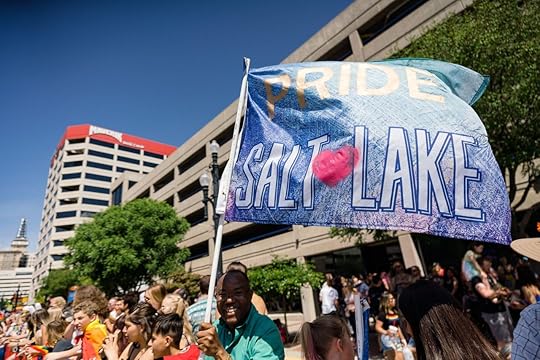
Photo: Austen Diamond Photography/Visit Salt Lake
Nowhere is this change more pronounced than in Salt Lake’s flourishing LGBTQ community. In 2015, Jackie Biskupski became the city’s first openly gay mayor. She currently serves with three openly gay city council members — Amy Fowler, Derek Kitchen, and Chris Wharton. SLC is so queer-friendly that officials renamed a street in honor of the politician and gay rights activist Harvey Milk in 2016. The same year Biskupski was elected, Gallup released a poll naming Salt Lake City the seventh gayest city in the United States. A whopping 4.7 percent of the population identifies as LGBT — a percentage higher than both New York City and Los Angeles.
It’s the ultimate irony — LGBTQ residents living in nearby states like Idaho, Wyoming, and Montana flock to Salt Lake City to find acceptance, just as the Mormons did for religious freedom in the 19th and 20th centuries. If Brigham Young could see what’s become of his Zion, he’d probably have a heart attack. Mormons spent the past century persecuting the LGBTQ community, but today, they’re living side-by-side in what both consider the land of milk and honey.
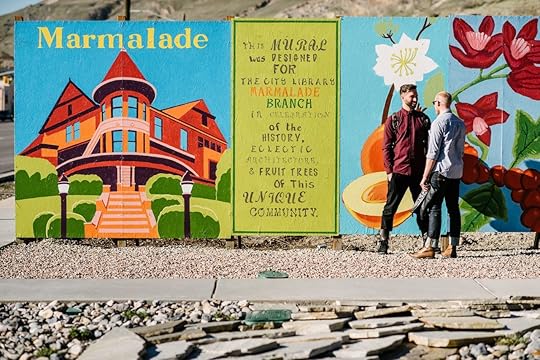
Photo: Austen Diamond Photography/Visit Salt Lake
In some ways, Salt Lake City is so gay it’s post-gay. You’ll find queer folks congregating in neighborhoods like Sugar Hill, the Marmalade District of Capitol Hill, and in the Avenues near Temple Square, but there’s no true gayborhood of which to speak. It’s easy to see why. The city is chockablock with hip coffee shops, international food options, artistic offerings, and enough outdoor activities to make you feel like you’re living in a Patagonia clothing ad. All of them are LGBTQ-friendly.
From the pink water of the Great Salt Lake to the snow-capped peaks of the rainbow-colored mountains, Salt Lake City is to Utah what Austin is to Texas: a liberal island in a sea of conservatism. Only while Austin wants you to “keep it weird,” the slogan Salt Lake City needs to start marketing is “keep it queer.” It’s got the queer part down pat — now it needs LGBTQ travelers to come experience it for themselves.
Bars and nightlife

Photo: Austen Diamond Photography/Visit Salt Lake
The Sun Trapp
Initially known as the Trapp, this all-inclusive dive opened its doors in 1990 only to be destroyed by a tornado nine years later. Although religious locals may have deemed the destruction a mighty act of God, the bar rose like Lazarus from the dead and now reigns supreme as SLC’s quintessential queer establishment. If you’re looking for a crowd, visit on Friday and Saturday nights when the outdoor patio and dance floor heat up with an eclectic mix of patrons. Arrive early — aside from the cheap drinks served in mason jars, this spot is popular because it’s one of only two gay bars in town; you’ll regularly find a long line waiting outside on weekends.
Where: 102 South 600 West
The Moose Lounge
This straight lounge becomes an LGBTQ dance club once every week for Revolution Fridays. Expect live DJs, drag queens, go-go dancers, and a weekly party theme inviting you to dress up so you can get down in style. Arrive before 11:00 PM for free entry.
Where: 180 West 400 South
Club Try-Angles
This laid-back bar is famous for cheap drinks, Thursday night karaoke, and Sunday BBQs on the patio between Mothers Day and Labor Day. The local crowd gets rowdy on the third Thursday of every month after checking their clothes for the Underwear Party. Leave the long Mormon garments at home — this event is more Andrew Christian than Joseph Smith.
Where: 251 West 900 South
Metro Music Hall
Although this midsize concert venue isn’t explicitly gay, Metro hosts the city’s best drag shows (it’s the number one place to find the girls of RuPaul’s Drag Race when they’re in town). Even when drag is off the menu, the space caters to SLC’s alternative crowd with a range of live events to suit almost everyone’s taste. Check the website to see who’s playing and buy tickets in advance.
Where: 615 West 100 South
LGBTQ ally establishments

Photo: Austen Diamond Photography/Visit Salt Lake
While nearly half the population is Mormon and only a handful of establishments are gay-centric, Salt Lake City is replete with queer-friendly businesses and activities.
Coffee and gays are both ex-nays for Mormons, and you’ll often find both frequently paired together. Coffee Garden, located on Harvey Milk Boulevard, is a long-running LGBTQ favorite with a rainbow flag hanging prominently in the window. Publik Coffee Roaster, a hipster java joint with two locations (one in the fashionable Avenues neighborhood and another closer to downtown) is another worthy stop with a small but mighty menu of light bites.

Photo: Laziz Kitchen/Facebook
If you’re feeling ravenous, join the “hummus-sexual” revolution by grabbing a meal at Laziz, a gay-owned Lebanese restaurant. For adult beverages (another Mormon no-no) try Bar-X, a Prohibition-era lounge co-owned by Modern Family star Ty Burrell. Check out Beer Bar next door while you’re there.
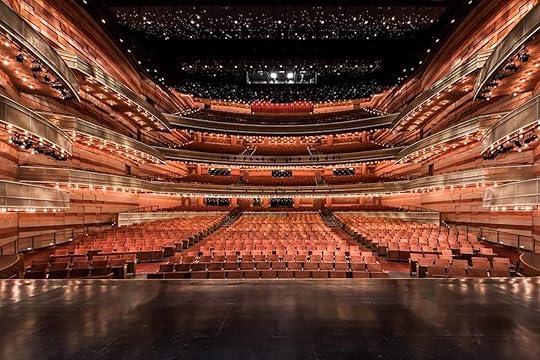
Photo: Broadway at the Eccles/Facebook
If you’re looking for late-night alternatives to loud bars, Salt Lake City is nationally renowned for its vibrant performing arts community. The Eccles Theater, a recently renovated arts complex located just south of Temple Square, hosts Broadway tours and concerts. Pioneer Theatre Company and Salt Lake Acting Company, two acclaimed regional houses, produce new works, pre-Broadway tryouts, and revivals of contemporary musicals and plays year-round.
Events
Utah Gay Ski Week

Photo: Elevation Gay Ski Week/Facebook
Park City, a 45-minute drive from downtown SLC, is a Wasatch Mountains town with Swiss Alps vibes that’s worth checking out at all times of the year. But for gay travelers, the area’s famous ski slopes have decidedly more swish during Elevation: Utah’s gay ski week. Between skiing all day and dancing all night, this five-day meet-up in Park City’s winter wonderland is the ultimate gay sleepaway camp. Check the website for dates and participating hotel recommendations.
Where: Park City, Utah
Damn These Heels

Photo: Utah Film Center/Facebook
The nearby town of Park City might have Sundance, but downtown Salt Lake City has Damn These Heels — an LGBTQ film festival that takes place every summer. In nearly two decades of operation, the weekend-long festival has screened over 220 films focused on telling stories by and about the LGBTQ community.
Where: Rose Wagner Performing Arts Center, 138 Broadway
LOVELOUD Festival

Photo: LOVELOUD/Facebook
In 2017, Imagine Dragons frontman Dan Reynolds began a family-friendly music festival to raise awareness, understanding, acceptance, and support for LGBTQ youth. The event, which takes place every summer in the USANA Amphitheater just outside SLC, has garnered national attention in past years with headliners like Kesha and Tegan & Sara. Proceeds from the festival benefit organizations like The Trevor Project, GLAAD, and the Human Rights Campaign, among others.
Where: 5150 Upper Ridge Road, West Valley City
Utah Pride Parade

Photo: Brent Olson/Shutterstock
When Salt Lake City threw its first Pride parade in 1990, around 250 people attended. Today, the parade regularly attracts upwards of 50,000 participants. The only local parade with larger crowds is Days of ’47, held in July, which commemorates the first Mormon settlers arriving in the Salt Lake Valley.
For a queer community with substantial ties to Mormonism, celebrating Pride is an inspiring act of bravery. It’s held on the Mormon day of worship, and participating is a symbol of defiance and a celebration of inclusivity and understanding. The parade, along with a Dyke March and interfaith service, takes place on the first Sunday in June and marches from 200 South West Temple to 400 East. Other events throughout the weekend include a 5K race, youth dance, film festival, and a series of speeches and live performances. The most well-attended event is the Pride Festival, which takes place on both Saturday and Sunday in and around Washington Square.
Where: 200 South West Temple to 400 East
Lodging
The Peery Hotel

Photo: Peery Hotel, Ascend Hotel Collection/Facebook
Originally built in 1910, this LGBTQ-friendly hotel in downtown SLC has a vintage feel with the comfort of modern amenities. It’s also a Hilton property, meaning Hilton Honors members can collect points to make the most out of their stay.
Where: 110 Broadway
Kimpton Hotel Monaco
This boutique hotel gives back to the LGBTQ community by donating to The Trevor Project, a non-profit focused on suicide prevention for LGBTQ youth. Housed in a historic bank building, each room is decorated with bold patterns, luxury linens, and all the amenities you could hope for. It’s also centrally located in the heart of downtown with easy access to the city’s greatest offerings.
Where: 15 West 200 South
Mister B&B
If you’re looking for an Airbnb-type experience but don’t want to end up in the home of a Mormon family, try this gay rental platform instead. It offers a range of accommodations for all types of needs.
Resources

Photo: Utah Pride Center/Facebook
The Utah Pride Center
This non-profit community center has been the beating heart of Salt Lake City’s LGBTQ scene since 1992. With counseling, support services, and programs like the Utah Queer Historical Society, the Pride Center is a safe space and valuable resource for locals and visitors looking to connect.
Where: 1380 Main Street 

More like this: The ultimate LGBTQ guide to Chicago
The post The ultimate LGBTQ guide to Salt Lake City appeared first on Matador Network.

Cheese rinds are safe to eat

When I have friends over, I set out a cheese plate. It’s a non-negotiable addition to every social gathering. We sit, we snack, and we drink wine. And, inevitably, a small plate ends up littered with discarded rinds. There’s hardly a more tragic — or more common — sight at the dinner table than a little pile of half-nibbled cheese bark, destined for the garbage can.
Maybe it’s the waxy texture. Maybe it’s the belief that many foods need to be peeled before they can be safely eaten. Well, have I got news for you, buddy: It is perfectly safe to eat the rind of your cheese. But that’s not why you should be eating them. If you don’t take a bite of your rind, you won’t be able to fully appreciate the cheese.
“As long as it’s not made of wax you can eat it,” Courtney Leedahl tells me. She and her husband, Brooks, run The Cheese Shop in Breckenridge, Colorado. And there’s more good news. “Some of the best characteristics of the cheese come from the rind.”
Here’s everything you’ve ever wanted to know about cheese rinds, and why you need to start eating them.
Different types of cheese rinds

Photo: Premier Photo/Shutterstock
First, you have to become familiar with basics: There are rindless cheeses, like chevre and Roquefort, a type of blue cheese, as well cheeses covered in wax or paper, which obviously you shouldn’t eat.
There are four different types of rinds. Natural rinds form, well, naturally on semi-firm and firm cheeses, like cheddar and Parmigiano-Reggiano, which are aged in the open air or in cheese caves. You’ll get earthy, even musty flavors — imparted from the damp cave walls — from this hard crust.
Leedahl also sees most people turn their noses up at bloomy rinds — the soft, almost fuzzy growth of white, pillow-like mold on a Brie or Camembert cheese. Bloomy rinds are achieved by applying edible mold to the cheese. Once the cheese blooms, the rind forms around the cheese like a protective casing.
However, it’s the washed rind that will likely pose the biggest challenge for newcomers to the rind. Washed rinds are formed by coating the cheese with a liquid. Sometimes it’s as simple as a salt brine, but wine, liquors like brandy, or beer are also used. These rinds have a distinct orange hue.
You might also run across bloomy rind cheeses at your local cheesemonger with visible patches of green or brown mold. Remember, bloomy rinds are literally formed by spraying the cheese with mold spores, so it’s still safe to consume these rinds — but you might not like the taste. There’s a good chance the flavors might be musty or funky, and it might even smell. But it won’t kill you to take a nibble. If the mold spreads to the paste of the cheese it will change its flavor, but even then it’s not dangerous. You can cut off the moldy spots and keep eating the unaffected areas without a worry.
Why eat the rind

Photo: STUDIO GRAND WEB/Shutterstock
According to Leedahl, the cheese rind is the best signifier of how the cheese was aged. “You really get a lot of the more of the terroir and a glimpse into the history of the cheese — where it came from,” she says.
Eating the cheese rind doesn’t just introduce more intense or concentrated flavors that you might find in the cheese itself — it is, as Leedahl puts it, an entirely “different animal” that introduces another layer of complexity the cheese. But eating the paste or the meat of the cheese in question doesn’t provide a full picture of its flavor. For instance, one of Leedahl’s favorite cheeses is a clothbound cheddar made by Jasper Hill Farms. The natural rind is a window into its cave-aged past, and it has a distinct and pleasant flower pollen flavor.
When you’re ready to dive into the rind, Leedahl recommends a cheese called Humboldt Fog, a bloomy rind goat cheese made by Cypress Grove. If you’re still skeptical, the crust of a familiar natural rind cheese like cheddar is always a safe bet, too.
Other ways to eat the rind

Photo: marcin jucha/Shutterstock
You can eat the cheese rind raw or on a slice of cracker, but there other ways to integrate cheese rinds into your dinners that don’t involve snacking on sliced cheese all day (although that does sound pretty great).
The hard, crumbly rind of Parmigiano-Reggiano, for example, adds instant salty and savory depth to pasta sauces like Bolognese. The rind doesn’t entirely melt, just softens, adding salty and savory depth to the sauce. Combined with cream, a hard cheese rind can also serve as the base for a cheese sauce for macaroni or potatoes au gratin.
If you’re prone to pairing many of your dinners with parmesan, you can always save the rinds, freeze them, and in the colder months use them to make parmesan broth. This rich broth can punch up pasta sauces or vegetable soup.
While cheese rinds are great for all sorts of sauces, you can also use them to create a condiment: Place a cheese rind in a jug of olive oil and let flavors from rind seep into the oil (the cheese won’t interfere with the consistency), then use the olive oil as a dipping sauce or salad dressing.
The crust of your cheese is so underappreciated. Cheese rinds are storytellers and chroniclers of cheese-aging history and versatile recipe boosters that hide intriguing flavors of their own. Don’t sleep on your cheese rinds — and pass the word on to your cheese-loving friends. 

More like this: This map shows Europe’s most popular cheeses by region
The post Only a monster would throw out the cheese rinds appeared first on Matador Network.

How to visit the wineries in Carmelo

There was a moment when Uruguay was in the running for the title of “it” destination. Visitor arrivals peaked in 2017, reaching roughly four million, or around half the number of tourists neighboring Argentina saw that year. Around the same time, Uruguay started showing up in travel publications that lauded its beaches and cool, progressive capital, Montevideo.
Tourism has stalled over the past couple of years, but Uruguay remains the ideal candidate for “the next big destination” that it never quite became. Montevideo radiates out from a nearly 14-mile waterfront rambla, unfurling into a network of eclectic neighborhoods. Holidaymakers head east along the coast during summer, flocking to mini-Miami Punta del Este and surfer retreats like Punta del Diablo. Some head inland to play cowboy at an estancia, a plot of land used to raise cattle.
It’s known that red-meat eaters are well fed in Uruguay, but it’s red-wine drinkers who should take note while planning their next big trip. While Argentina and Chile get most of the attention for South American wine, there’s no place better in the world to taste big, bright, fruity tannat.
Where Argentine winemakers famously bottle malbecs to pair with chimichurri-doused steak, Uruguay’s signature red wine grape stands up to even the heartiest helping of asado. The blue-black tannat grape comes from southwestern France, but has been strongly identified with South America since its introduction by French Basque settlers centuries ago. It thrives in Uruguay’s clay-rich soil, yielding a less aggressively tannic, but no less bold, wine than its French kin.
Other wine regions, like those in California and Texas, have started experimenting with tannat as well. But only one country in the world calls tannat its national grape. If you aren’t sold on Uruguay’s beaches alone, perhaps its wine, and wine country, will have you reconsidering your vacation calendar this year.
Where to start a wine trip in Uruguay

Photo: Bodega Familia Irurtia/Facebook
For the dedicated wine tourist, Uruguay makes tasting easy with Los Caminos del Vino, or The Wine Roads, a designated drinking trail that weaves together about 20 wineries around the country. Nice as it is to have so many options, the idea of winery-hopping across an entire nation, even one as small as Uruguay, may seem exhausting. Luckily, the choice is easy if you want a more localized getaway: All you have to do is head west from Montevideo as everyone else flocks to the sand and surf on the opposite end of the coast.
Though the majority of Uruguay’s wine production comes from Canelones and greater Montevideo, wine tourism is finding a new home in the town of Carmelo in the southwestern part of the country by Brazil. Previously, visitors to western Uruguay mainly went to see Colonia del Sacramento, a former Portuguese settlement with a UNESCO-listed historic quarter, and maybe hop the hour-and-change ferry to Buenos Aires. Increasingly, visitors are tacking wine-fueled day trips onto their itineraries. And for good reason. Not only does nearby Carmelo enchant with its tastings, but it also makes some of the country’s finest wine thanks to the region’s agricultural advantages.
It’s generally a few degrees warmer in the Colonia department than elsewhere in Uruguay, meaning grapes ripen early and there’s less risk of frost in vineyards. Carmelo is located near the confluence of the Uruguay and Paraná rivers, which creates a favorable microclimate, and the Río de la Plata estuary, which has a mineral-rich soil that brings out the best in tannat, syrah, pinot noir, and other grapes.
Easy living in Colonia’s wine country

Photo: Narbona, Uruguay/Facebook
Chances are, you’ll be hooked on Carmelo even before arriving at your first winery. The town itself is sleepy but kind and charismatic. Taxis are generally available around Plaza Independencia, the main square, and the drive into the countryside is a highlight in itself. Lanes of tall eucalyptus trees lead to bolts of pasture dotted with cattle. Rosemary and lavender bushes fill out the landscape. And then you see vineyards.
Waiting at the end of one of the longer, and more pleasant, drives is the Narbona Wine Lodge, about 20 minutes from downtown Carmelo. Neighbored only by its own dairy farm, it’s endlessly photogenic with a periwinkle paint job, big checkerboard patio, and 15 hectares of vineyard. Each perfectly appointed antique serves not only as a decor touch but also as a testament to the winery’s more-than-100-year history, which is chronicled at the on-site museum.

Photo: Narbona, Uruguay/Facebook
Tastings are held beneath the museum in a private cellar decorated with racks of special-occasion Luz de Luna, or “Moonlight,” bottles. Opt for the cheese pairing compliments of Narbona’s dairy farm. Though the winery in Carmelo only serves reds and rosés, there’s a sister restaurant in Punta del Este that also serves the label’s white wine.
Laid back as it is, Narbona screams romantic weekend away while the standout wineries closer to downtown Carmelo tend to feel more down-home. In many cases, that’s because they’re family run. At Bodega Familia Irurtia, one of the area’s largest producers, owner Maria Irurtia often personally leads tours of her family’s estate, which has been producing wine since 1913. Ten minutes in another direction, Bodega El Legado owner Bernardo Marzuca and son have been known to offer wine straight from the barrel while sharing the story of how Marzuca built the warm, rust-red winery in tribute to his late father.
It’s a red-heavy wine country, but should the craving for white strike unexpectedly, you’re in luck: Posada Campotinto is only a few minutes from downtown Carmelo, though its viognier would be worth traveling for. There, you can also arrange for a picnic in the vineyard that will spoil you for all other picnics, with cheese and charcuterie boards, perfect views, and, of course, great wine.
It’s worth more than just a day trip

Photo: Estudio Pixies/Shutterstock
Though the Colonia del Sacramento to Carmelo day trip seems to be en vogue with travelers, you could easily spend two or three days ambling down the town’s dusty, winery-dotted roads. After all, tastings in Carmelo, like everything else, are relaxed and unhurried.
In between winery visits, get to know downtown on foot or by bike. Take in landmarks like Plaza Independencia, the harborfront promenade, and the historic red swing bridge, a point of pride for Carmelitanos. Learn more about the town at the local museum and archive. Later, walk or cycle all the way to Playa Seré to laze on the banks of the Río de la Plata, or venture out to the Calera de las Huérfanas ruins and uncover what remains of the 18th-century Jesuit church and mission. If you’re into nesting side trips like Russian dolls, you can even plan a day trip to Tigre, Argentina, on your weekend trip to Carmelo from Colonia del Sacramento.
Where to stay in Uruguay’s wine country

Photo: Ah’Lo Posada Hostel Boutique/Facebook
With more to do than what’s immediately apparent, you may find yourself spending little time at whatever accommodation you choose. Nonetheless, in Carmelo, it’s easy to end up someplace that’ll make you want to hang around the room a little bit longer.
To start, both the Narbona and Campotinto wineries have rooms. Choose Narbona’s Relais & Chateaux lodge to be greeted by the warm smell of fresh bread baking at the on-site panadería, a stone’s throw from the restaurant where meals are served. In the back, peruse the small shop stocked with artisan goods like fresh pasta, sauces, olives, oils, and a freezer full of dairy products all bearing the Narbona name. Farther up the estate, the exclusive five-room lodge overlooks the vines and a pool made for lounging. Guests also have access to the private beach in Puerto Camacho.

Photo: Narbona, Uruguay/Facebook
Then there’s Campotinto, equal parts rustic and elegant. It’s the best place to kick back with a glass of wine in town and has the advantage of actually being in town, or at least a few minutes away. Go for Campotinto if you want to commune with nature while keeping amenities, and other wineries, nearby. Complimentary bicycles are available to guests who wish to spend their days cycling between the area’s vineyards.
Though not a winery itself, the five-star, 20-bungalow Carmelo Resort & Spa from Hyatt is only a few miles from Bodega Familia Irurtia. And it has a really big pool. It is a luxury hotel, however, and the price tag reflects that. To make things a little easier on the wallet, try the AH’LO Posada Hostel Boutique downtown. You can’t miss it with its bright pink facade, though you probably will miss its sweet, tidy dorms and cute outdoor nooks the next time you check in to a hostel. 

More like this: The 7 most exciting places to travel to drink wine in 2019
The post If you weren’t already sold on Uruguay, go for the wine appeared first on Matador Network.

Benefits of Nordic outdoor naps

When our eldest was a baby, we’d swaddle her in a warm wool blanket, place a hat on her head, and lay her down in a cozy, Swedish-made stroller that laid out flat like a bed. We’d go out for a walk in the chilly Seattle weather, and in no time at all, she’d be asleep. Then we’d come home, roll her and her stroller out to the back porch and let her nap — for a solid two hours at a stretch.
This was nothing new to my husband’s parents, who did the same for him when he was young — placing their bundled baby boy out on the balcony of their Helsinki apartment, even in the middle of Finland’s brutal winter. Anywhere you go in the Nordic countries this is common practice. Walk through Norway’s capital Oslo in November, and you’ll see strollers lined up outside restaurants — the swathed babies sleeping comfortably while their parents lunch inside.
Even more jarring may be jogging through the back streets of Copenhagen, Denmark, on a darkening autumn afternoon. You may see a stroller parked outside a brick apartment building, with a baby monitor placed by the little one’s feet, so parents know when it’s time to come outside to collect their well-rested child. Even in Iceland, which experiences some of lowest average temperatures of the Nordic countries, babies nap outdoors — in summer and winter. Especially in winter.

Photo: riggleton/Shutterstock
“I think we think it’s good to be outside. You get a lot of fresh air,” says Annemari Koivula, a resident of Stockholm, Sweden, on the practice of having babies sleep outside. All three of Koivula’s sons started sleeping outside nearly as soon as they were home from the hospital, at one or two weeks old. “Every day. For two hours,” she adds.
Each of Koivula’s baby boys slept in his stroller on the balcony or in the inner courtyard of their building. Sometimes Koivula would take the baby out for a walk and meet a friend, and the two parents would chat outside or grab a coffee somewhere while their babies slept in their strollers. Koivula also says that when she and her husband went cross-country skiing outside their hometown in Arctic Lapland, they’d pull a Nordic skiing baby-carrier along with the youngest boy cozily wrapped up within it. “They slept very well,” she said of her boys’ turns in the Nordic baby carrier.
Having babies sleep outside is common practice in Finland and Scandinavia, where it’s believed that babies sleep better and longer in crisp outdoor weather. It’s also thought that sleeping outside is good for immune systems, and that it provides a reprieve from the germs and microbes that can get trapped indoors during the coldest months of the year.
Koivula, who is also a practicing physician, knows the arguments about the indoor germs, and thinks there may be some merit. But she thinks maybe babies who sleep outside are healthier simply because they sleep better when it’s cold. And a better-rested child tends to be a healthier one. “It’s kind of tradition. But kids sleep better. When it’s cold, they sleep better… That’s a mother’s point of view.”
Starting life outdoors and keeping it that way

Photo: Pressmaster/Shutterstock
The Nordic embrace of outdoor time for children doesn’t end when kids give up napping. Spending time outdoors lasts straight through the school years and, really, into adulthood. In Finland, classes for kids in “comprehensive school” — grades one through nine, roughly equivalent to US elementary and middle school — last 45 minutes, with 15-minute intervals for outdoor recess between every single class.
For Eevi Paasivaara, the many breaks are a pretty recent memory. She’s now in her final year in high school in Helsinki but spent her comprehensive school years at a small, coastal town called Tammisaari. There, she had frequent outdoor breaks, regardless of the weather.
“For 15 minutes after every lesson, it was compulsory to go outside. You weren’t allowed to stay inside, even if it was raining,” she says. “It was the parents’ job to make sure their children had the appropriate clothing.”
The only exception was extremely cold weather. “If it was colder than minus 15 [five degrees Fahrenheit], you didn’t have to go outside,” says Paasivaara.
Paasivaara says her teachers told students that going outside would help them learn better. For younger kids, there are also social benefits to frequent outdoor recesses, as kids have to play with one another. When Paasivaara and her classmates hit middle school, the teachers also said going outside and even just standing was still more exercise than they’d get sitting around inside. And no matter how much they tried to get out of it as teenagers, says Paasivaara, “We always got caught and had to go outside.”
Despite the adolescent rebellion, Paasivaara says she feels all the outside time was beneficial. “I felt like it definitely helped. It was sort of refreshing to come back after being outside for 15 minutes. The fresh air helped you concentrate.”
Outdoor play is good for kids

Photo: Kichigin/Shutterstock
It turns out that the benefits of outdoor play — even in cold weather — are so well demonstrated in studies that the American Academy of Pediatrics recommends outdoor play for kids all year long. A Pennsylvania Department of Health’s newsletter urged parents to have their kids play outside during the winter — noting a host of benefits, from learning to health.
“Children should have a minimum of 30 minutes of outdoor play a day,” says Dr. Shannon Thyne, Professor of Pediatrics at UCLA’s David Geffen School of Medicine. Dr. Thyne says time outside can have positive effects on learning because “It’s stimulating to the mind. It gets the heart rate up, which allows you to be calm once you go inside.”
In the same way we say that kids should have no more than two hours of screen time, Dr. Thyne says, “They should have no less than 30 minutes of active outdoor play.”
“It’s intuitive, but there’s also evidence in several studies that outdoor time is good for kids. Giving kids those opportunities builds resilience. When you send someone to a park, they’re using their minds in creative ways,” she explains.
Being outdoors stays with you

Photo: Elizaveta Galitckaia/Shutterstock
In the Nordic countries, the weather hardly ever stops anyone from going outside. In fact, there’s a common Finnish saying about weather, which translates roughly to, “There’s no such thing as the wrong weather; just the wrong clothing.”
Paasivaari says that now that she’s in high school, she has longer classes without the built-in outdoor breaks — but when she and her friends do have a free moment, they’ll still often head outdoors. “My friends and I might take a walk outside because it’s sort of refreshing. You’re used to being outside. It stays with you.”
At a time when Americans are fretting about studies that show we are spending more time than ever inside, maybe we should stop spending so much energy trying to get adults outside and focus on kids. Paasivaara wouldn’t have had it any other way, she says. It was helpful in her earlier school years and makes her appreciate being outside now.
“It’s good for the mind and the soul,” she says, adding that, in her view, “If you don’t get used to it from a young age, it’s a bigger step when you’re an adult.” 

More like this: Traveling with your kids makes them better in school, new study says
The post What we can learn from the Nordic culture of outdoor naps and play appeared first on Matador Network.

Weirdest Valentine’s Day traditions

Valentine’s Day conjures a very specific image in the United States — namely, all things red and pink and heart-shaped. But Valentine’s Day is not an exclusively American celebration, and cultures around the world have many different ways to observe the holiday. Here are 11 different Valentine’s Day traditions from around the globe — maybe try one of these out on your sweetheart this year and do something different from the standard roses and boxes of heart-shaped chocolates.
1. Argentina

Photo: Arcor/Facebook
In Argentina, one Valentine’s Day per year just won’t do. During “Sweetness Week” or “La Semana de la Dulzura,” held the first week of July every year, lovers, family members, coworkers, and friends exchange candies for kisses by asking “a candy for a kiss.” According to The New York Times, the candy Bon o Bon helped establish the holiday week in 1989 with the advertising slogan “A Bon o Bon for a kiss.”
2. Estonia
For those who are newly or chronically single, every mention of Valentine’s Day feels like salt being rubbed in a wound. In Estonia, locals celebrate Sõbrapäev, or “Friend’s Day,” and focus on the bonds of friendship rather than on romantic love.
3. Denmark

Photo: Denmark.dk/Facebook
Denmark celebrates Valentine’s Day with a minimalist flourish. Instead of dramatic red roses, lovers and friends exchange homemade cards resembling paper snowflakes called gaekkebrev. Inside each of those cards is a pressed snowdrop flower, as well as a funny love poem or riddle. The cards are signed with dots (each dot representing a letter in the name of the sender) and if the person receiving the card correctly guesses who sent it to them, they get a chocolate Easter egg from the sender that year.
4. South Africa
In South Africa, Valentine’s Day is celebrated with flowers, chocolates, romantic dinners, and gifts, just as it is in many other parts of the world. There is one major difference, though: Valentine’s Day is also a day for South African women to literally wear their hearts on their sleeves. In a tradition dating back to the ancient Roman festival Lupercalia, women (and sometimes also men) write the names of their sweethearts or love interests down and pin them on their sleeves, which is an excellent way to communicate one’s secret crush.
5. Bulgaria

Photo: R R/Shutterstock
While most of the world celebrates St. Valentine’s Day, Bulgaria makes merry for St. Trifon Zarezan Day, or Winemakers Day, an old festivity rooted in ancient celebrations of Dionysus, the god of wine. The day is dedicated to the first labor of the year for vine-growers and winemakers — trimming the unnecessary branches on the vines at the beginning of February — complete with its own legend around St. Trifon Zarezan. While there has been public dispute over which saint to honor come February 14, modern celebrations combine the two — celebrating romantic love right alongside wine in a match made in heaven.
6. Brazil
Instead of Valentine’s Day, Brazilians celebrate Dia dos Namorados, or “Sweethearts’ Day,” on June 12, when couples exchange all the usual chocolates, flowers, gifts, and cards. Although Dia dos Namorados is a made-up commercial holiday, it was carefully scheduled to happen on the eve of St. Anthony’s Day (June 13), the matchmaker and protector of lovers in Brazilian folklore. On that day, single women pray and practice rituals to St. Anthony in the hopes of finding a husband. One of these rituals consists of drowning an image of the saint upside down in water until the right man comes along and proposes.
7. Germany

Photo: Friva/Shutterstock
Germans celebrate Valentine’s Day in much the same way that Americans do, but with one especially noteworthy addition: They also give each other pigs. Not a full-grown, 500-pound hog, but little pig-shaped trinkets, as well as chocolate pigs representing luck and lust. Instead of the more common gift of chocolates, Germans also exchange giant heart-shaped gingerbread cookies with romantic messages written in frosting.
8. China
China doesn’t celebrate Valentine’s Day as we know it on February 14th; Chinese people have their own day devoted to lovers called Qixi, or the Seventh Night Festival. This festival is held on the seventh day of the seventh lunar month each year. According to Chinese folklore, it’s the one day of the year two star-crossed lovers, Zhi Nu, a goddess from heaven, and Niu Lang, a mortal cow herder, are permitted to reunite thanks to a bridge of magpies. Qixi is celebrated very differently throughout China (with lanterns in Taiwan or small handcrafted gift from women to their love interest in parts of China), but flowers and chocolates are definitely part of it.
9. Wales

Photo: Nacho Mena/Shutterstock
In Wales, Valentine’s Day does not take place on February 14. Instead, the Welsh celebrate St. Dwynwen’s Day, the Welsh patron saint of lovers, on January 25, when young men give their sweethearts intricately carved wooden “lovespoons.” Today lovespoons are given at many different kinds of celebrations including weddings, anniversaries, and christenings. St. Dwynwen’s Day is celebrated with cards, gifts, and romantic dinners — altogether pretty familiar, despite the difference in date and saint.
10. France
Paris is known as the City of Love because it’s considered one of the most romantic destinations in the world, but the real destination for lovers in France is simply the small village of Saint Valentin. A two-day festival — complete with horse-drawn carriage tours around the village, Valentine’s Day dinners and dances, and love letter exhibits — takes place every year to celebrate the holiday and attract visitors from all over the world. In the village’s “lovers’ garden” you can pin a heart with a message on the metal “Wishing Tree.”
11. Japan

Photo: show999/Shutterstock
In Japan, Valentine’s Day is all about women spoiling their men. And while chocolate is still the preferred sweet for the occasion, the kind of chocolate given says a lot about the woman’s fondness (or lack thereof) for the man. High-quality “true feeling” chocolates (or honmei choco) are given to spouses, romantic, and would-be romantic partners, while lesser-quality “obligation” chocolate (or giri choco) is given to casual friends and colleagues. On March 14, known as “White Day,” men who received the good stuff return the favor. These days, the tradition of giri choco is controversial and going out of fashion in work environments. 

More like this: The 7 most underrated romantic cities in the world
The post 11 Valentine’s Day traditions around the world appeared first on Matador Network.

Berlin is freezing rental prices

In an effort to slow the gentrification of the city, Berlin is freezing or lowering rental prices on over 1.5 million apartments for five years. The measure was approved Thursday, January 30, 2020, by lawmakers, and will take effect next month, to the delight of many, especially lower-income and older residents, who are being forced out of their homes by rent increases.
As reported by The New York Times, Katrin Lompscher, Berlin’s senator for city development and living, said, “We have created an instrument that will stop the partially absurd price developments for the next five years. It is up to politicians to create the basic conditions for lower- and middle-class earners to be able to afford to live in Berlin.”
The law will cap rents in the city at 2019 levels, and also limits how much can be charged based on the apartment’s condition and amenities. According to Lompscher, the aim of the freeze is to ease the pressure on renters during a period when rental prices are skyrocketing.
Critics, however, believe that the freeze goes against the country’s Constitution, which holds that rents can be set by the federal government. Jürgen Michael Schick, the president of Germany’s Real Estate Association, said, “The rent cap is equivalent to an expropriation and is a catastrophe for Berlin’s real estate market. Limiting and reducing the income from rents will create uncertainty for investors and will ward off real estate developers from investing.”
The tenants of those apartments, however, probably aren’t too sympathetic to Schick’s investment concerns. 

More like this: How to experience Berlin’s famous counterculture
The post To slow gentrification, Berlin is freezing rent prices for five years appeared first on Matador Network.

Matador Network's Blog
- Matador Network's profile
- 6 followers



